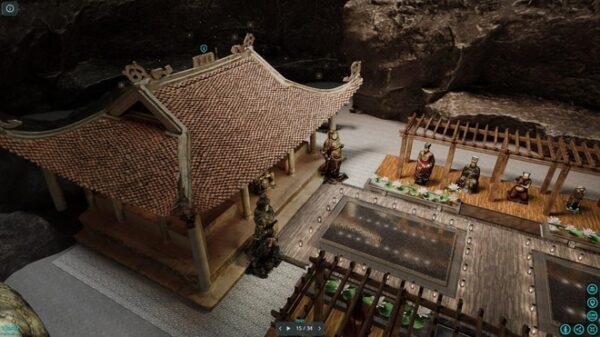The concept of digitization has been mentioned since about 2010 – 2011, but it was not until 2014 – 2016 that it became more familiar because a few projects of non-specialist units self-financed implementation and announced. However, the role of digitization only really comes into play at the time of the outbreak and raging of the Covid-19 pandemic. To prevent epidemics, the entire world employs social distancing measures such as closing the skies. People are compelled to adapt and change old behaviors since they are no longer able to travel as freely as they once were. Cooking at home instead of going out; watching films at home rather than going to the cinema; travel, visit, exhibitions, museums… all rely on technology. The pandemic is really a terrifying obsession, but when it gradually passes, it also leaves some impact.
Heritage Digitization: Who is leading?
|
|
| Online interactive 3D museum (Source: Nguyen Tri Quang) |
Just like Hoan Kiem or Dong Da (Hanoi) districts have built a 360 information page in a self-guided way, the Center For Scientific and Cultural Activities Mieu – Quoc Tu Giam is preparing for a big digitization project. This project is officially approved for funding in 2021, implemented in 2022 and completed in 2023. Mr. Le Xuan Kieu – Director of the Center For Scientific and Cultural Activities of Van Mieu – Quoc Tu Giam said, The construction of a digital database of the Temple of Literature includes both tangible and intangible heritage items. In particular, intangible heritage includes historical documents, information related to relics. For the part of the physical heritage, apart from architectural works, the most important thing is still the system of Doctor’s stele (82 stelea once recognized as a private heritage by the United Nations Educational, Scientific and Cultural Organization – UNESCO). The application of science and technology to build a 3D digital database for the special national Temple of Literature is expected to bring about the following effects: Forming an electronic archive of the database on Temple of Literature for management and search; Helping exploit data content easily and quickly; Through electronic data management, effectively serving conservation work in a comprehensive, scientific, convenient, safe manner… Digitization is also expected to increase the ability to preserve and restore in case of natural disaster, fire…
However, according to Mr. Le Xuan Kieu – Director of the Center For Scientific and Cultural Activities of Van Mieu – Quoc Tu Giam, if just stopping at the above elements, it indicates that the project will be done and stored until there is an event where it will be used. In order for digitization to be truly meaningful, in addition to preserving and preserving, it must also promote the value of cultural heritage. This means that further steps are required. It is building an interactive system on smart devices, QR Code applications, image recognition, 3D recognition, and multimedia experience… Visitors only need to download the “app” to interact, visit the Temple of Literature right on their smartphone with 3D space, view multimedia content (movies, photos…), and communicate with the “virtual” assistant through the AI technology (artificial intelligence), positioning GIS (tools used to collect, analyze, store data and create maps transmitted from positioning systems such as GPS for business use), resource management, image recognition, etc.). Digital technology will help people experience and explore relics in the most convenient and comfortable way. Along with that, it is promoting Hanoi’s tourism activities with a night experience program at the Temple of Literature on the basis of technology application. This is the next step of the cultural industry that Hanoi has been pursuing and actively implementing over the past 2 years.
In a few meetings about Program No. 06-CTr/TU dated March 17, 2021 of the Hanoi Party Committee on cultural development, raising the quality of human resources, and building elegant and civilized Hanoi people in the period of 2021 – 2025, Director of the Center For Scientific and Cultural Activities of Van Mieu – Quoc Tu Giam proposed to build a common database and a unified software for Thang Long – Ha Interior culture. That is, the Imperial Citadel of Thang Long, Dong Da, Hoan Kiem, and other districts… must implement digitalization on an uniform technology platform. This is to avoid the circumstance in which each heritage is a type that cannot link due to incompatibility. Then, from the shared system, Hanoi will join the national system. That is, the Ministry of Culture, Sports and Tourism also needs to build a common system for the whole country.
Mr. Tran Dinh Thanh (Deputy Director of the Cultural Heritage Department, Ministry of Culture, Sports and Tourism): Deploy 7 tasks and solutions under the Cultural Heritage Digitization Program
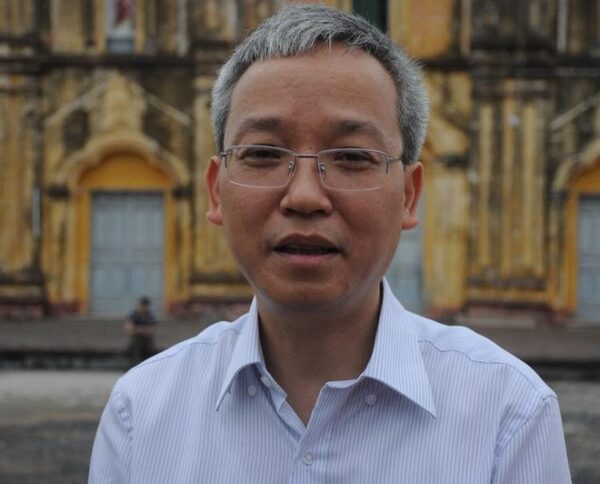
Currently, the digitization program is being synthesized by the Department of Cultural Heritage for local opinions to develop specific implementation plans for provinces and cities; implementing the project “Building a foundation and database for management, protection and promotion of cultural heritage values” nationwide. At the same time, according to the implementation roadmap for the 2021 – 2025 period, 7 tasks and solutions under the Cultural Heritage Digitization Program for the 2021 – 2025 period will be implemented (Improving mechanisms, policies and legal regulations; Building a digital platform and common sets of standards on archiving; Building and creating digital data on cultural heritage; Managing, operating and exploiting the National Database on Heritage cultural property; Ensuring network safety and security; Improving the quality of human resources; Promoting international cooperation”.
Still waiting for the instructions
In the previous period of this series of articles, we also highlighted the situation raised by Ms. Pham Thi Lan Anh, Head of Heritage Management Department, Department of Culture and Sports, Hanoi. That is, at present, there have not been any guiding documents of the Ministry of Culture, Sports and Tourism on the issue of digitization since Decision 2026/QD-TTg issued on December 2, 2021 approving the “Chapter the process of digitizing Vietnam’s cultural heritage in the period of 2021-2030”. And Ms. Pham Thi Lan Anh’s point of view is also the same as that of the Director of the Center For Scientific and Cultural Activities of Van Mieu – Quoc Tu Giam Le Xuan Kieu – which urgently needs national synchronization. If we wait for the Ministry of Culture, Sports and Tourism, how long will it take?… In fact, to what extent does the Ministry of Culture, Sports and Tourism do, what technology, what technology is used, and what is the technological foundation, and whether the locals should do it first or wait? Many heritage managers in the provinces, not only Hanoi, are concerned about it..
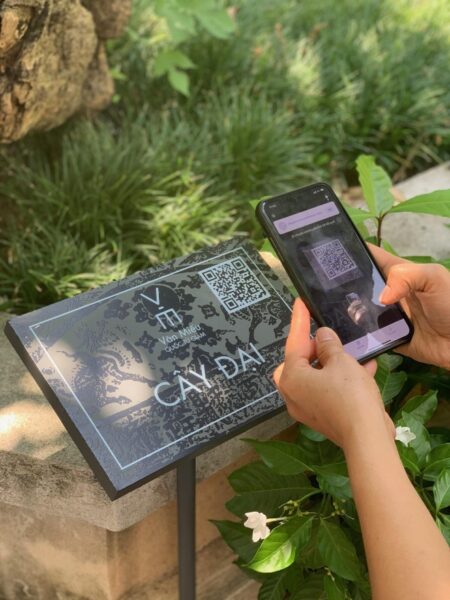 |
| The Center For Scientific and Cultural Activities of Van Mieu – Quoc Tu Giam provides information on QR codes of relics… |
However, that is only the policy side, when implemented, many obstacles will arise in the process of digitization. According to Mr. Hoang Quoc Viet – Chairman of the Board of Directors cum CEO of Viet Professional Software Solutions Joint Stock Company (Vietsoftpro – the unit in collaboration with the National Museum of History to digitize 23 national treasures), difficulties sometimes do not lie in professional work. Many localities are enthusiastic about doing it, but there is absolutely no specific guidance on funding and budget. That is the reason why many localities still hesitate to deploy. Mr. Hoang Quoc Viet analyzed: “From this story, I still wonder that if everyone was so concerned, everything would stand still. Meanwhile, information technology is always upgraded. I can take this funny example, when doing heritage digitization, to get a good photo, sometimes you have to take hundreds of photos just to choose the perfect one. But when paying, you only get paid for one photo, and the effort to take the rest of the photos will not be taken into account. So, I think, the problem here is not just expertise but a good mechanism. I go to the local, see a lot of places want to do, but they are afraid of the mechanism”.
Tien Le communal 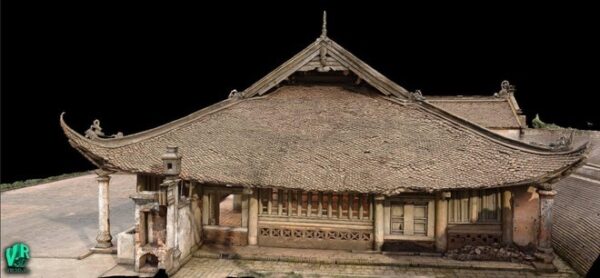 house (Tien Yen commune, Hoai Duc district, Hanoi) has become the first major relic to be kept and displayed in its original state by digitization and 3D interactive technology (Source: Nguyen Tri Quang) house (Tien Yen commune, Hoai Duc district, Hanoi) has become the first major relic to be kept and displayed in its original state by digitization and 3D interactive technology (Source: Nguyen Tri Quang) |
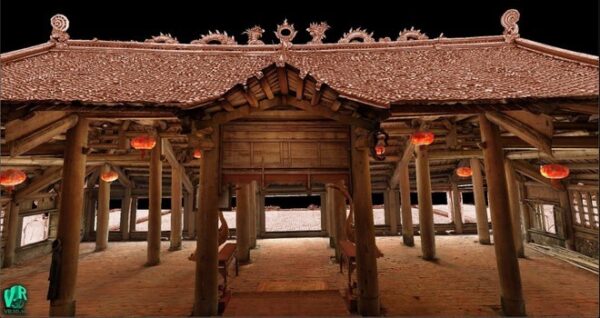
It has been 9 months since Decision No. 2026/QD-TTg was approved by the Government on December 2, 2021, in which: “Assigning the Ministry of Culture, Sports and Tourism to assume the prime responsibility with other ministries and local authorities formulating specific plans and programs to organize the implementation, take responsibility for the results and effectiveness of the program”. In fact, up to this point, many establishments, units and provinces are impatient to digitize first because the 10-year term seems long, but the huge amount of work, 10 years is still short. However, they were concerned that “if you do it first, but the Ministry proposes another approach, will it be a waste not to link later?”…
Mr. Hoang Quoc Viet (CEO of Vietsoftpro Company – the unit working with the National Museum of History to digitize 23 national treasures): Applying a common model will easily lead to creative suppression.

“There are two ways to digitalize cultural heritage in the world today. Firstly, the State needs to invest in building a shared system, then localities and management establishments will digitize their own heritages, relics and artifacts and upload them to that system. Second, the State does not need to do anything, but only needs to set standards and criteria… so that lower-level establishments can still actively make their own products. They just need to make sure their products will share, link with the products of other establishments and localities across the country. I see the world they often choose option 2. The reason is, if you choose option 1, it is easy to become obsolete because technology changes very quickly, the previous year compared to the next year was much different. In addition, if you keep applying the general model, it will easily lead to the destruction of creativity. Therefore, the State should only set standards, which means that establishments and localities rely on it to do as well as, or even be creative, to do better than the State’s standards.
I take for example, now the State assigns my company to make a shared product, but next year another company can make something better? Should I force them to downgrade the product to match my company’s product? Thus, the State is giving me a monopoly, and the technology monopoly will fail anyway. I may be superior this year, but next year I may be behind. Then the State should only assign criteria and standards. In general, digitizing cultural heritage is like a train, each train car is a facility or locality. Institutions and localities want to decorate, invest, paint, and create their train carriage in any way, as long as it is beautiful, safe and effective. But it is imperative that the carriages have standard joints to hook into other cars and with the locomotive to run forward. That is the diversity in a unified entity, it helps to mobilize all social resources. I see countries around the world do it this way. In addition, it must be affirmed that the digitization of cultural heritage is a very large program, so it is necessary to mobilize all social resources to be successful”.
Mr. Le Xuan Kieu (Director of the Center for Cultural and Scientific Activities of Van Mieu – Quoc Tu Giam): Effectively building a 3D digital database of relics
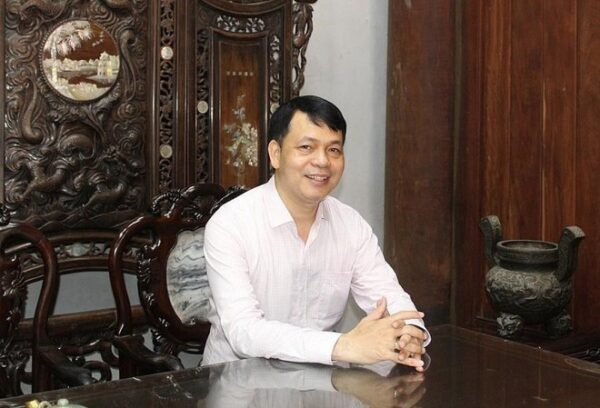
– First, form an electronic archive with the most complete scientific database on the Temple of Literature for storage, management and retrieval, making it easy to exploit data content through electronic data management.
– Second, the digitization and data standardization to complete the digital archive database at the management archive will serve as the foundation and primary source of information and data to promote the use of information technology in the management and preservation of cultural heritage documents in various fields, effectively serving conservation work in a comprehensive and scientific manner. Improve management, storage, data mining, and the image of the Temple of Literature in particular, as well as Hanoi City tourism operations in general, to make them more effective, convenient, and safe.
– Third, increase the ability to preserve and prolong the life of cultural heritage, promote the value of cultural heritage through interactive activities and search documentary information about the Temple of Literature.
– Fourth, build an information technology infrastructure system (server for storing and managing digital data; Kiosk for touch screen lookup; VR virtual reality glasses; connection infrastructure …) to create the most authentic and lively space for tourists, but still keep the characteristics of the national culture, combining modernity and tradition, and actively promoting the Temple of Literature regularly, widely to the public at home and abroad, contributing to the digital transformation in tourism activities, developing cultural industries and responding to Hanoi’s participation in creative city networks.
 |
| Temple of Literature |
The Museum’s Story: Despite the risks, determination to digitize the deritage
Heritage digitization is an unavoidable development in museums worldwide. When the Covid-19 epidemic is intricate and direct access is impossible, digital museums will make it easier for the public to view and visit online. Digitization, in addition to promoting and presenting, preserves heritage and artifacts for the future. The final issue is determining how to make it appealing and well-received by the general population. When speaking with Capital Security about this issue, Master Nguyen Thi Thu Hoan, Deputy Director of the National Museum of History, expressed the same concern.
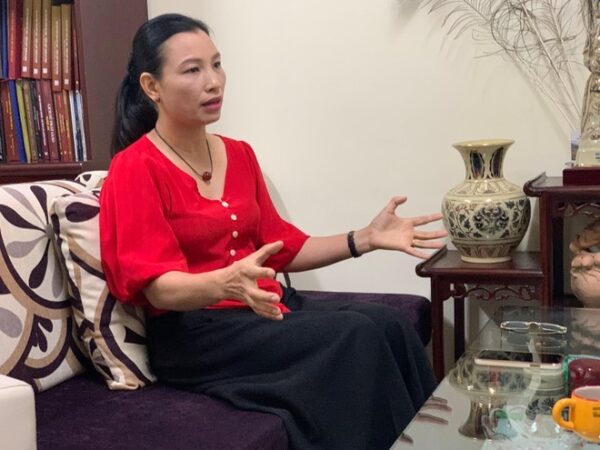 |
| Master Nguyen Thi Thu Hoan – Deputy Director of the National Museum of History |
– Reporter: The National Museum of History is a place to keep a lot of precious cultural artifacts and heritages of the country, and is also one of the agencies that actively take the lead in digitizing their archives. Where did the museum get this positive attitude, ma’am??
– Master Nguyen Thi Thu Hoan – Deputy Director of the National Museum of History: Digitization of heritage and museum artifacts has many levels and we have been doing it for a long time. However, at first, we just did simple data entry. As for the intensive implementation such as the application of 3D techniques, the Museum of Ethnology also had an idea before, but it has not been implemented. Until 2013, when we cooperated with Vietnam Professional Software Solutions Joint Stock Company (Vietsoftpro), we put it into practice.
It should also be noted that, because it was our first time, we only digitized based on thematic presentation, specifically two topics: “Vietnamese Buddhist cultural heritage” and “Vietnamese antique lamps.” The goal at the time was just to bring those two concerns to the public’s attention in order to prevent waste. These two themes were only on display at the museum for a few months, but it is worth noting that the preparation was incredibly difficult. All efforts of the museum are focused on introducing from the beginning of the AD to the present time. And then we thought, the whole topic consumes so much enthusiasm, the material is so full, but not all people have the conditions to come and enjoy. It would be a waste to end up with nothing to keep. At that time, there was an opinion that the museum should make catalogs and photo books for later introduction and storage. However, if you just stop there, it will be very limited. Fortunately, at that time, Vietsoftpro appeared and came up with the idea of digitizing the exhibition to keep forever. So we started implementing and until now, those two topics can still be visited on the museum’s website.
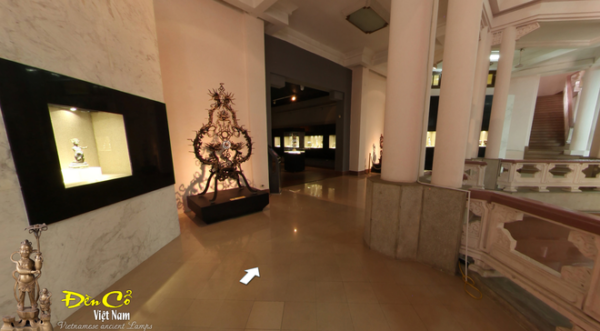 |
| Online thematic exhibition “Vietnamese antique lamps” by 3D technology with more than 50 artifacts dating from about 2,500 years ago to the early twentieth century, including ceramic, iron, copper, wood… especially a bronze lamp in the shape of a kneeling man in the Dong Son period signed the Decision on recognition of national treasures by the Prime Minister (Source: National Museum of History) |
– After that experiment, when confident enough to implement digitizing artifacts and heritage, did the museum ever think about the situation that it would fall into an “offside” position when “go ahead and take the lead”?
– Yes! But we don’t mind because it’s the museum’s responsibility to do what’s best for its specialty. It must also be added that the National Museum of History has the advantage of being invited to international scientific conferences. We go to foreign museums and see that digitization has become a very common thing, so why not do it? Once that question is answered, the only problem left is technology.
After the success of 2 topics, we started to think further, which is to digitize the entire system of artifacts under our management. But unfortunately, the budget problem will be very expensive and the conditions of the museum do not allow it. So we thought of making a permanent display system, from prehistoric times to the Dong Son culture period, as if we were doing it while experimenting. In addition to 3D visualization, we also have an interactive section with experts. During the process, we keep building content for the artifact and Vietsoftpro does the technical part. It must be said that at first we did it in a stub, the 3D image was just 3D rotated 360 degrees. However, feedback from the public shows that they are interested, understand more, enjoy more… Moreover, cyberspace offers the advantage of not being limited in the amount of information like on display. Digitized artifacts also have the beauty that when we want to see details, just “zoom” again will be clear. That gives the public a very good visual perception.
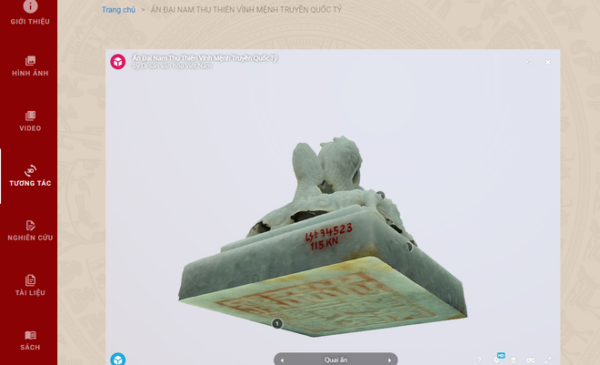 |
| The image of the seal “Dai Nam got the mandate of heaven, emperor’s seal” – a national treasure is 3D digitized by the National Museum of History |
Following that, we came up with the idea of doing a specific exhibition outside of the museum, that is, it will be totally “virtual,” but it must fit the criteria of “virtual but real” in order to attract visitors. Due to tight distance requirements, visitors to the museum were essentially non-existent when the Covid-19 broke out, so we decided to do it as soon as possible. This decision runs the risk of having to be accepted if the outcome is not as expected. All that remains after you’ve made your decision is to get to work.
– What are the results of the online exhibitions during the 2 years of the Covid-19 pandemic and how much has the museum digitized so far, madam?
– During the epidemic’s two years, we created content to introduce national treasures entirely in 3D. And, as you can see, everyone can now watch. Students could even learn history by viewing the exhibitions online. Those who haven’t had the chance to visit the National Museum of History can now view treasures and heritage artifacts with full information and detailed annotations. However, we have only digitized the topics in 3D to present to the public, but the museum’s existing materials have not been digitized. If you want to digitize, you must first create information and papers, which takes time and effort.
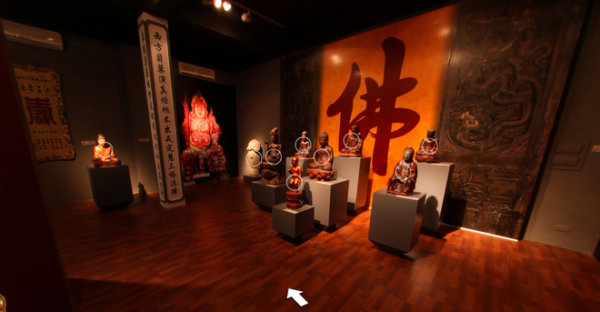 |
| The National Museum of History organized an online exhibition titled “Vietnamese Buddhist Cultural Heritage” by 3D technology, introducing nearly 200 documents and artifacts dating from the early AD to the Nguyen Dynasty including paintings, Buddha statues, architectural decoration of pagodas and towers, worshiping objects, musical instruments and so on. |
– According to your opinion, can the museum’s digitization work soon be replicated, because up to now many cultural heritages have disappeared and the awareness of many State management agencies on this issue also seems to be low?
– Many people believe that digitizing artifacts, monuments, and cultural heritage will proceed in the same manner as we are. Then, to be completely honest, those things are only done to introduce the artifacts and advertise our museum. That is not what we call digitization. To digitize, the first step is to understand what digitalization is. It must have a database base, which is a challenging issue to solve. Now I ask, where to store all that I have done? How to exploit and develop it? And to what extent? Who will do it? Not to mention building infrastructure. No matter how good I am at digitizing, if the system malfunctions, it will all go to zero.
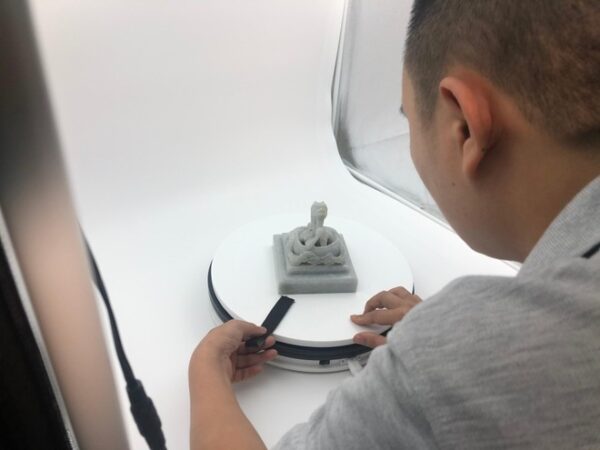 |
| Experts performed 3D scans of the “ Dai Nam got the mandate of heaven, emperor’s seal” – a national treasure kept at the National Museum of History. |
We’re currently dealing with the issue of having to send any artifacts we’ve digitized to Vietsoftpro to keep. They are doing it completely for free, and there is no commitment if they are no longer interested in us tomorrow. Digitization, in addition to mining, must be preserved such that if the artifact is lost later, we only need to recover the data to obtain a 1:1 duplicate. However, there is a risk that if the material falls into the wrong hands, copies will be extensively distributed for commercial or fraudulent purposes. So, we return to the question I just raised about infrastructure. It is still unknown who will run it and how secure it will be. Not to mention that we will face the story, individuals who do technology are unfamiliar in cultural heritage, and people who do cultural heritage are not proficient in technology.
– There is a story like this, the Public Security and Customs sectors caught the cases of smuggling antiquities abroad. However, after obtaining the material evidence, they did not know where it belonged to to return it. In your opinion, if the cultural industry can digitize the heritage, will those antiques return to their original place?
– This story speaks to two problems. Firstly, I remember someone said before that it is necessary to attach a QR code to identify objects, the reason is because with goods with billions of products, people can still do it, it is not difficult to do with the present. property, heritage. People do not understand QR codes in commerce and the museum industry are two different stories. Digitizing applications in museums must be systematic, must be “linked” together to become a smart museum, a digital museum. Therefore, that commercial thinking cannot be used as a culture. Second, we just digitized the national treasures, the actual 3D scanning won’t take too long. But the arrangement of which one with which one to “link” together, to look up this and that, into an intelligent system, that’s the scientific story.
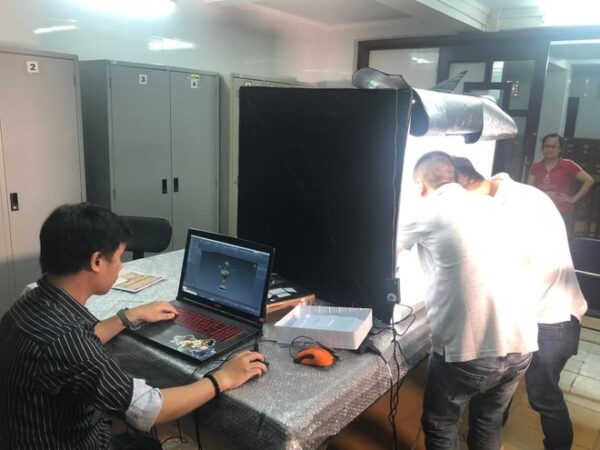 |
| Performing 3D digitization of artifacts at the National Museum of History (Source: Vietsoftpro) |
Recently, there was also a newspaper asking us about the qualifications of the Police and Customs officers when they could not recognize the antiques. I’ll be honest, they don’t have any archeology training to know. It is not right to ask them to distinguish one is old-fashioned and the other is fake. Even us or archeologists who spend their whole lives studying antiquities sometimes can’t tell the difference without specialized mechanical support, let alone police and customs officers. But if we can do digitization for antiquities then this will solve it. However, I think that’s just promoting the positive effects of digitization.
– How long will it take to digitize all of the museum’s artifacts at the current speed?
– This question is difficult to answer because it goes back to the story at the beginning. I remember in a conference someone shared a story about a technologist building software and guiding museum staff to use it. But museum staff just typed the wrong code or entered the wrong data, which led to a system error. Therefore, I think that in order to digitize, it is necessary to choose urgent artifacts first, and then for treasures of great value such as national treasures. But to synchronize with more than 200,000 artifacts of the National Museum of History, I really don’t know how to say it, because it is also related to the problem of funding.
This was the case at our museum. The contract with the technology unit includes a provision for performing system maintenance and repairs. But they went bankrupt, and we had no idea how to solve it. When doing digitalization work, I am really concerned about this issue. In the near future, we will construct information fields advance, which will take a significant amount of time. However, we simply prepare it for digitization later.
– Thank you for the exchange!
What is the purpose of digitization if we put it in one place and then hold the key, waiting for the visitors to come and open it?

“Digitization will first help us in management. When the management is good, the value of the heritage will be promoted. For example, people can view the national treasures that we manage and have 3D digitized, it serves very well for education and can make books, media, tourism promotion… A smart museum is that just “click” the mouse, everything will “link” together. But if we just keep the heritage in one place and hold the key, wait for this person to come and open it to let them in, what’s the point of talking about digitization!”.
Master Nguyen Thi Thu Hoan (Deputy Director of the National Museum of History)
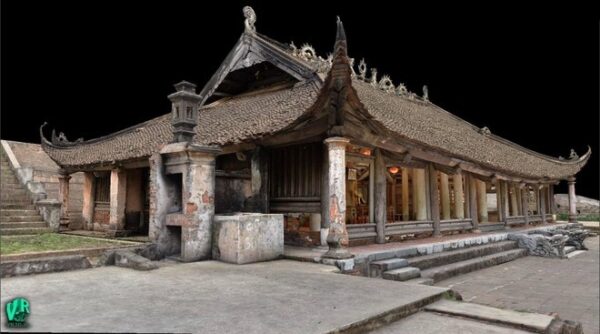 |
| Tien Le Communal House has become the first major relic to be kept and displayed in its original state by digitization and 3D interactive technology. |
(Continues)
Vân Quế- Tả Minh- Trần Quân- Tuấn Dũng
Số hóa để di sản hồi sinh và khơi dòng lịch sử (3): Đường dài còn lắm gian nan (anninhthudo.vn)


